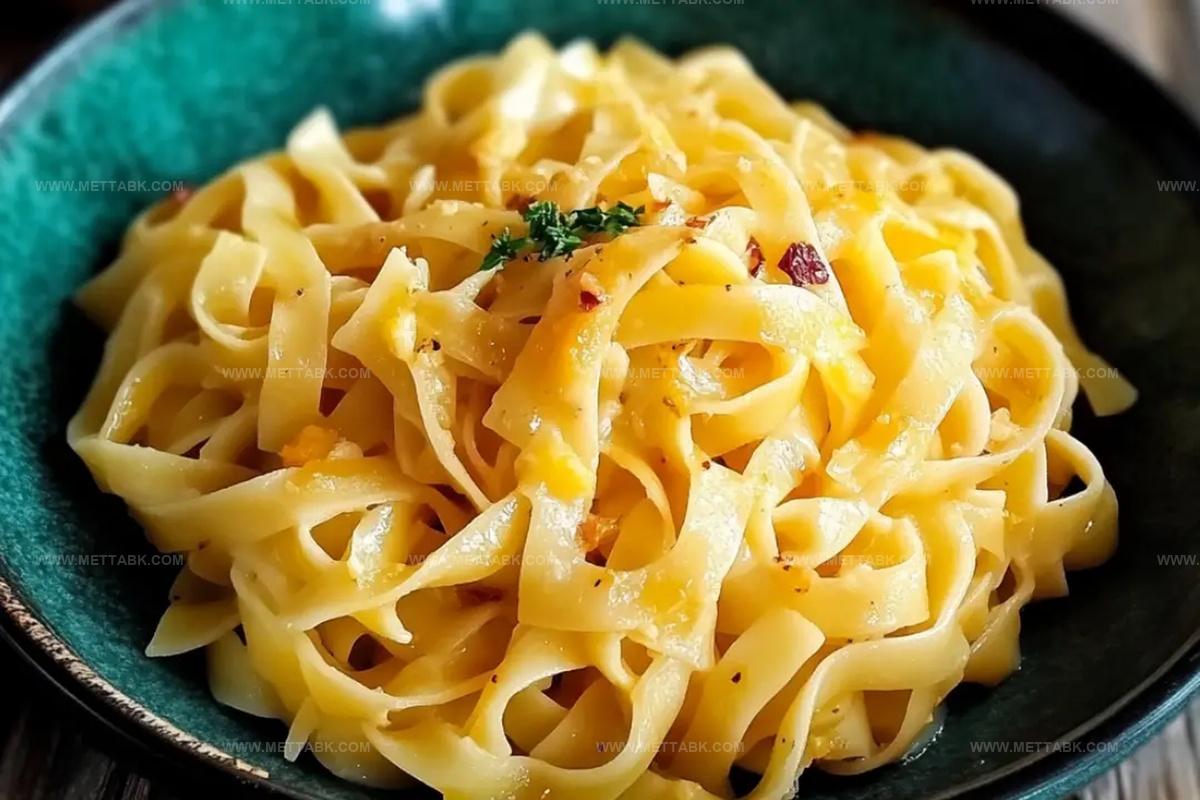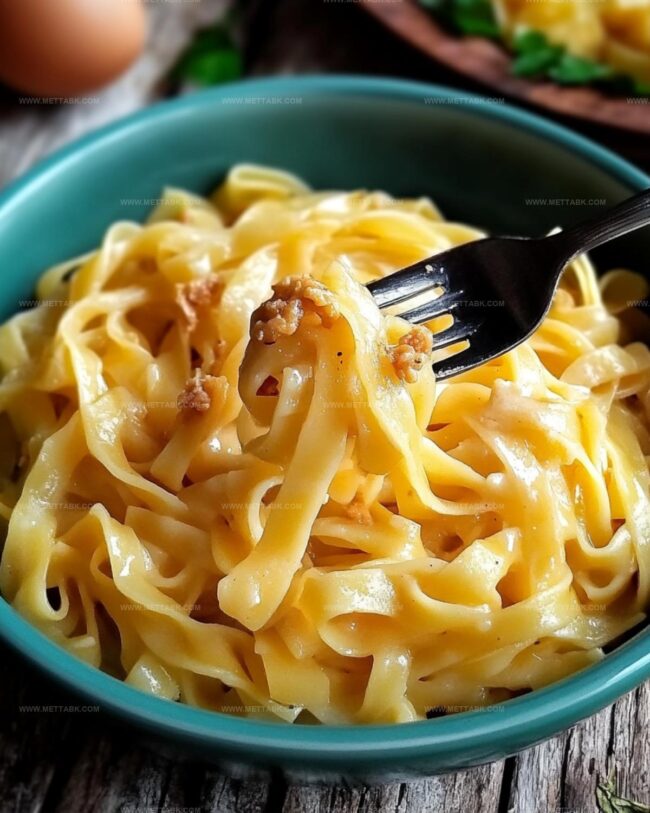Simple 3 Ingredients Homemade Egg Noodles Recipe From Scratch
Crafting delectable homemade egg noodles with just three ingredients sounds like a culinary adventure waiting to unfold.
Pasta making becomes surprisingly simple when you understand the basic technique.
Wheat flour, eggs, and a pinch of salt form the magical combination for these tender strands.
Kitchen novices and seasoned cooks alike can master this straightforward recipe with minimal effort.
Each ingredient plays a crucial role in creating the perfect noodle texture and flavor.
Fresh eggs bring richness, while flour provides structure and salt enhances the overall taste.
You’ll be amazed at how quickly these noodles come together, promising a delightful homemade experience that beats store-bought options every time.
3-Ingredient Homemade Egg Noodles Made Simple
Ingredients for Quick Homemade Egg Noodles
For the Base:For the Seasoning:How to Make Egg Noodles from Scratch
Step 1: Create Silky Dough Base
In a spacious mixing bowl, gather your flour, eggs, and salt. Blend these ingredients thoroughly using a fork or whisk until a cohesive mixture forms.
Work the ingredients gently to ensure even distribution.
Step 2: Knead to Perfection
Transfer the dough onto a clean surface.
Use your hands to knead the mixture, pushing and folding repeatedly. Continue this process for approximately 10 minutes until the dough transforms into a smooth, elastic texture that feels soft and pliable.
Step 3: Allow Dough to Rest
Cover the kneaded dough with a clean kitchen towel or plastic wrap. Let it sit undisturbed at room temperature for half an hour.
This resting period allows gluten to relax and enhances the noodle’s final texture.
Step 4: Roll and Shape Noodles
Divide the rested dough into two equal portions.
Using a rolling pin or pasta machine, stretch each section into thin sheets. Cut the sheets into desired noodle shapes – wide ribbons, thin strands, or classic linguine-style strips.
Step 5: Boil and Cook
Fill a large pot with water and bring to a rolling boil. Carefully drop the fresh noodles into the bubbling water.
Cook for approximately 60-90 seconds or until the noodles start floating on the surface, indicating they are perfectly done.
Step 6: Prepare for Serving
Drain the cooked noodles in a colander.
Rinse briefly with cold water to stop the cooking process. Gently toss with a small amount of olive oil to prevent sticking and add a touch of flavor.
Step 7: Store or Serve
You can serve the noodles immediately with your favorite sauce or protein. Alternatively, allow them to cool completely and store in an airtight container in the refrigerator for short-term use or freeze for future meals.
Tips to Get Perfect Noodles Every Time
Variations to Add Flavor or Color
Pairing Suggestions to Serve With Noodles
Storage Advice for Fresh Egg Noodles
Store cooked egg noodles in an airtight container for 3-4 days. Seal tightly to prevent moisture and keep them fresh in the coldest part of the refrigerator.
Transfer cooled noodles to freezer-safe bags or containers. Remove excess air, label with date, and freeze up to 2 months. Prevent freezer burn by using thick, quality freezer bags.
Quickly warm noodles in microwave for 30-45 seconds. Sprinkle few drops of water to prevent drying. Stir halfway through heating for even temperature.
Thaw overnight in refrigerator. Warm in skillet with small amount of butter or oil over medium heat. Stir gently to restore texture and prevent breaking.
FAQs
You can use all-purpose flour for this recipe. No need for fancy or specialty flour types.
Yes, you can roll out the dough with a rolling pin and cut it manually with a knife or pizza cutter. A pasta machine helps but isn’t required.
The dough should feel smooth and elastic, not sticky or dry. When you press it, it should spring back slightly and feel cohesive.
Add a few drops of water gradually while kneading. If too wet, sprinkle small amounts of flour until the texture becomes smooth and manageable.
Print
3-Ingredients Homemade Egg Noodles Recipe
- Total Time: 41 minutes
- Yield: 4 1x
Description
Silky homemade egg noodles elevate simple ingredients into a comforting culinary experience. Pasta lovers will savor these tender, fresh noodles that bring warmth and tradition to any meal.
Ingredients
Main Ingredients:
- 3 eggs
- 2 cups (240 grams) flour
Seasoning:
- 1/2 teaspoon (2.5 milliliters) salt
Instructions
- Gather flour, eggs, and salt in a mixing bowl, blending the ingredients thoroughly until a cohesive dough forms.
- Transfer the mixture onto a clean surface and vigorously knead for approximately 8-10 minutes, developing a smooth and pliable texture.
- Shape the dough into a compact ball, then wrap with plastic film and allow it to rest at room temperature for 25-35 minutes, enabling gluten relaxation.
- Unwrap the dough and slice it into two equal portions using a sharp knife.
- Utilizing a pasta roller or rolling pin, flatten each portion into thin, translucent sheets, aiming for a consistent thickness.
- Cut the flattened dough into desired noodle shapes using a sharp knife or specialized pasta cutter.
- Prepare a large pot of salted water, bringing it to a rolling boil at 212°F.
- Gently lower the fresh noodles into the bubbling water, cooking for 45-60 seconds until they rise to the surface, indicating doneness.
- Quickly drain the noodles in a colander, rinsing with cool water to halt the cooking process.
- Lightly coat the noodles with olive oil to prevent clumping, then serve immediately or store for future use.
Notes
- Use room temperature eggs for smoother dough consistency and easier mixing.
- Experiment with different flour types like semolina or whole wheat for unique textures and nutritional variations.
- Knead the dough thoroughly to develop gluten, ensuring a more elastic and tender noodle structure.
- Let the dough rest to relax the gluten, making rolling and cutting much easier and preventing tough noodles.
- Fresh homemade noodles cook faster than store-bought, so watch carefully to avoid overcooking.
- For gluten-free option, substitute all-purpose flour with almond or rice flour and add xanthan gum for binding.
- Store unused noodles in an airtight container in the freezer for up to one month to maintain freshness.
- Add herbs like basil or parsley to the dough for extra flavor and aromatic complexity.
- Prep Time: 40 minutes
- Cook Time: 1 minute
- Category: Lunch, Dinner, Snacks
- Method: Boiling
- Cuisine: American
Nutrition
- Serving Size: 4
- Calories: 353 kcal
- Sugar: 0.3 g
- Sodium: 293 mg
- Fat: 15 g
- Saturated Fat: 4.9 g
- Unsaturated Fat: 9.5 g
- Trans Fat: 0.1 g
- Carbohydrates: 35 g
- Fiber: 1.2 g
- Protein: 14 g
- Cholesterol: 186 mg



Nate Harper
Founder & Recipe Curator
Expertise
Single-Recipe Development, Farm-to-Table Cooking, Seasonal Menu Planning, Culinary Storytelling, Home Kitchen Innovation
Education
Cascade Culinary Institute – Central Oregon Community College
Certificate in Culinary Arts
Focus: Farm-to-table cuisine, sustainable cooking practices, and seasonal recipe creation.
Nate studied under experienced chefs who emphasized local sourcing, minimal waste, and building recipes from fresh, simple ingredients.
Nate Harper is the founder and creative force behind Make, Take, Bake. Raised in the wild beauty of Oregon’s high desert, Nate grew up surrounded by family gardens, farmers’ markets, and home kitchens that celebrated the seasons.
His early love for simple, honest food evolved into a professional passion when he attended Cascade Culinary Institute, where he sharpened his skills in creating recipes that are sustainable, satisfying, and made for everyday life.
Nate’s goal is to make cooking feel accessible, free of fuss, and full of flavor. He believes a single, thoughtfully built dish can stand alone, and sometimes even steal the show.